Asus ROG Strix G15 review (G513RW – AMD Ryzen 9 6900HX)
This is my detailed review of the Asus ROG Strix G15 2022 series, their everyday all-purpose/gaming laptop built on AMD Ryzen and Nvidia RTX hardware for this generation.
The ROG Strix G15/G17 series is Asus’s mid-range lineup of performance and gaming laptops, pretty much their best-value mix of features, performance, and pricing.
These laptops are full-size formats with powerful hardware inside, so not focused on portability. They’re also a slightly trimmed variation of the top-tier Strix Scar 15/Scar 17 series, with some changes in aesthetics, IO, and configuration options, but similar in overall format, functionality, and capabilities.
For the 2022 generation, the ROG Strix lineup is where Asus offers the latest AMD and Nvidia hardware platforms, as the Scar 2022 is an Intel-exclusive implementation now.
In this article, we’re going over the mid-upper Asus ROG Strix G15 G513RW configuration, which pairs an AMD Ryzen 9 6900HX processor with 16 GB of DDR5 memory, an RTX 3070Ti graphics chip (with a MUX), and a QHD fast and high-gamut display. This configuration is pretty much the sweet spot for the 2022 Strix G15 series, and what I expect many of you interested in a high-performance AMD ROG laptop to be looking at.
You’ll find all my impressions down below, with the positives and the quirks that you should be aware of before jumping on one of these.
Specs sheet as reviewed – 2022 ASUS ROG Strix G15
2022 ASUS ROG Strix G15 G513RW
Display
15.6-inch, 16:9, non-touch, matte, Chi Mei CMN1540 panel
QHD 2560 x 1440 px IPS, 240 Hz with 100% DCI-P3
Processor
AMD Rembrandt Ryzen 9 6900HX, 8C/16T
Video
AMD Radeon 680M + Nvidia GeForce RTX 3070Ti Laptop 8GB (up to 150W with Dynamic Boost)
with MUX and Adaptive Sync (no GSync on internal display)
Memory
16 GB DDR5-4800 RAM – up to 64 GB (2x DIMMs)
Storage
1 TB SSD (Micron 2450) – 2x M.2 PCI 4.0 x4 slots
Connectivity
WiFi 6E (Mediatek MT7922) 2×2 with Bluetooth 5.2, 2.5Gigabit LAN (Realtek RTL8125)
Ports
2x USB-A 3.2 gen1, 1x USB-C with data, 1x USB-C gen2 with video, data and charging, HDMI 2.1, LAN, headphone&mic
Battery
90Wh, 280 W power adapter, USB-C charging up to 100W
Size
354 mm or 15.55” (w) x 259 mm or 11.1 (d) x 27.2 mm or 1.07” (h)
Weight
2.32 kg (5.11 lbs), .99 kg (2.2 lbs) power brick and cables, EU version
Extras
rubber-dome per-key RGB backlit keyboard with NumPad, quad speakers, no webcam or biometrics
We might follow up with reviews on other GPU configurations if there’s enough interest. I’m especially interested in the budget-tier RTX 3060 model, the ROG Strix G15 G513RM, but the top-tier Strix G15 G513RS variant with the RTX 3080 graphics should also be an interesting analysis, as the most powerful AMD-based ROG laptop of this generation.
Update: Here’s our coverage of the updated 2023 Asus ROG Strix G16 and Strix G18 lineups. And our thoughts on the 2023 ROG Strix G17, which is now based on an AMD Ryzen HX platform. And here’s our review of this 2023 Asus ROG Strix G17 model (Ryzen 9 7945HX + RTX 4070).
Design and construction
The Strix G15 series is a simplified Scar 15 in looks and overall design.
The two are the same size and format, as rather compact, but at the same time fairly thick and heavy 15-inch laptops. You can tell their compact footprint from the size of the bezels around the screen, but these laptops are still fairly deep, with the thicker chin under the display and the extra hump behind the screen, which incorporates the cooling, most of the IO, and some of the speakers.
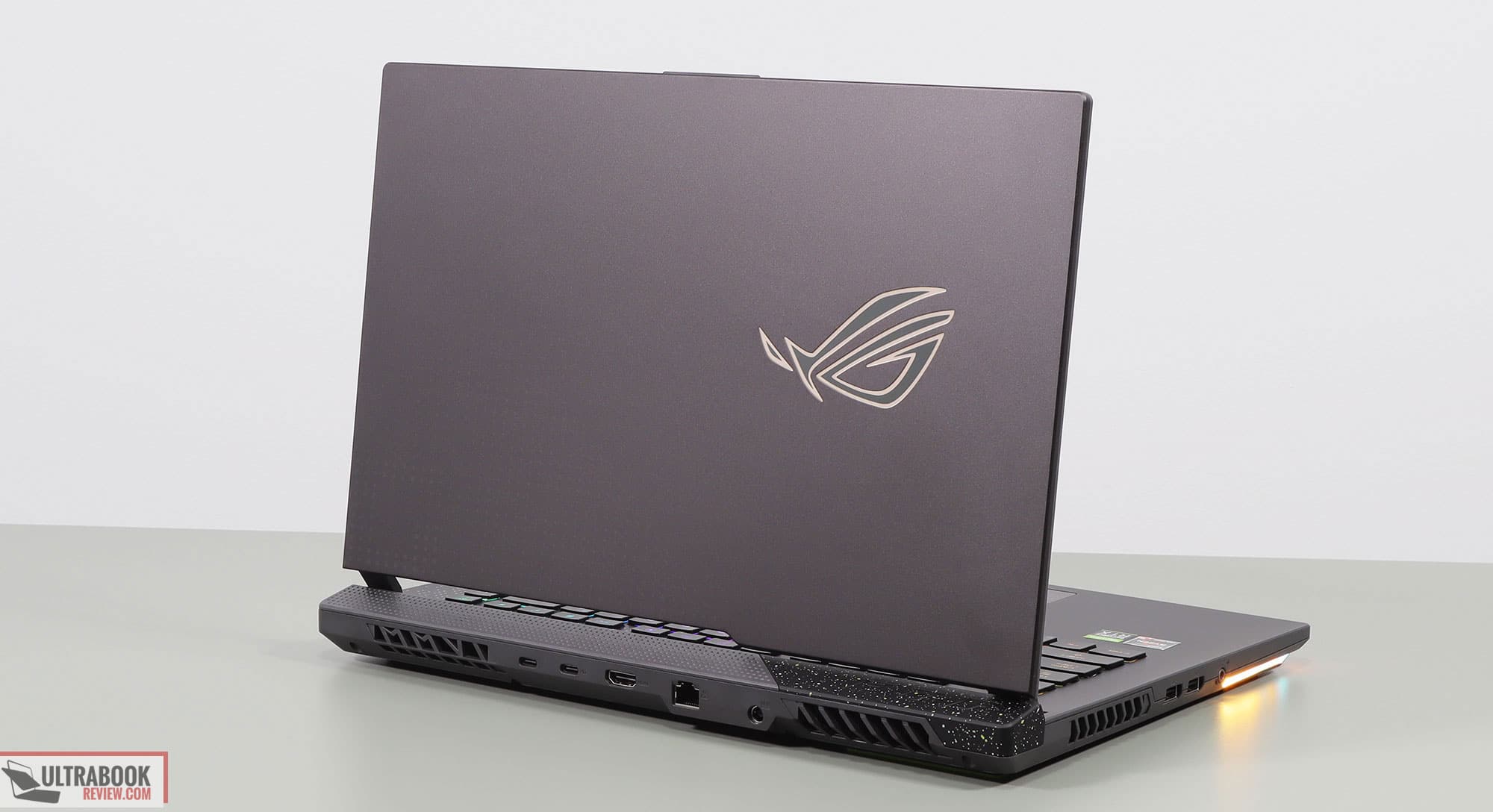
Compared to the Scar, the Strix G15 gets a simpler design and a dark-gray color scheme, which does a better job hiding smudges. The main deck is still made out of smooth plastic, and the lid is aluminum with a rougher finishing.
The main differences are subtle, and I find most to be an advantage for the Strix G15. The status LEDs are smaller and less annoying on this series, even if they’re still placed under the display, and there’s no longer that translucent part of the main deck that lets you peek at the components, which is exclusive to the Scar series. Instead, the interior is a more unified design, with only a subtle pattern of black dots for the right side, where the translucent part is placed on the Scar.
Then, the ROG plastic cap to the left-back side of the laptop is no longer user replaceable on this series, and instead has been replaced with a fixed piece that looks rather interesting, with the speckled dotted design.
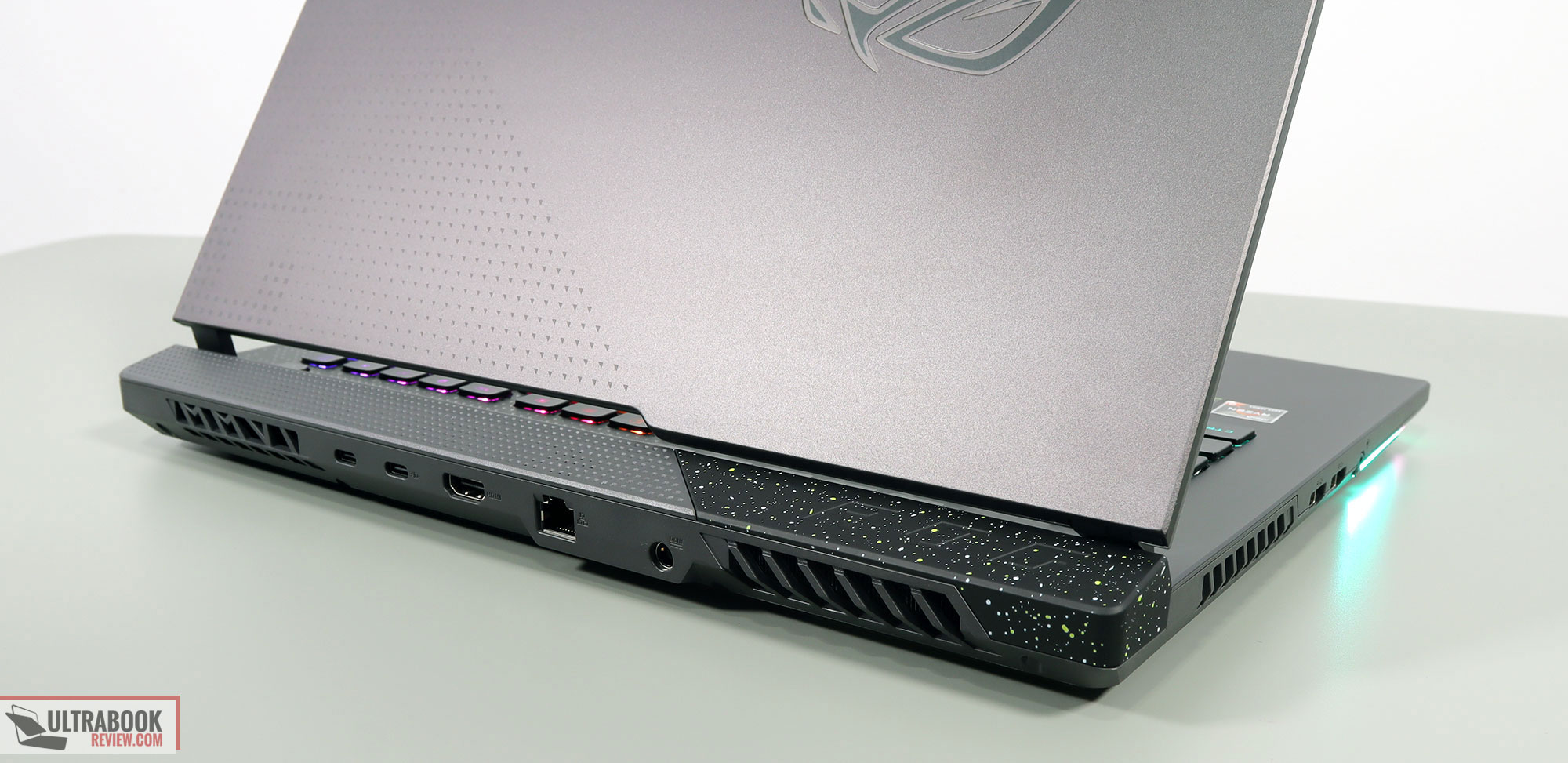
There are also fewer RGB elements implemented on this mid-tier lineup, without the extra RGB bar under the screen and without RGB control over the ROG logo on the lid – this is instead panel-lit and cannot be manually adjusted or switched off.
Finally, there’s no longer a Keystone on this series, but that’s hardly any loss. No ports have been added to that right edge instead, which just doesn’t offer any connectors, as most of the IO is still on the back and some on the left side.
The PSU, HDMI, and LAN ports are tucked on the rear edge, behind the screen, and there are also two USB-C ports over there. One of them supports data, power, and video (connected to the dGPU) and the other is data only. The HDMI port hooks into the Nvidia dGPU as well, and it’s HDMI 2.1 on the latest variants, like on the Scar 15. That aside, there’s still no card reader on this series, no security locks, and no biometrics.
The practicality is otherwise so so, with the rubber feet offering good grip on the desk and the hinges sturdily keeping the screen in place, while allowing to pick it up and adjust it single-handedly. I also find the arm-rest spacious enough and the front lip and corners friendly on the wrists, despite the laptop’s fairly tall profile.
The screen, on the other hand, only leans back to about 110-degrees, which can be very limiting for couch or lap use.
Overall, this 2022 ROG Strix G15 is a fair design, but with a rather bizarre set of ports and some quirks that affect its practicality with daily use. Up to you how much these would weigh in your purchase decision.
Keyboard and trackpad
The keyboard on the 2022 ROG Strix G is identical to the one on the ROG Strix Scar with this generation, both implementations with standard rubber-dome switches.
For this 15-inch model, the layout includes a full set of main keys, smaller and spaced-out arrows, and two extra function groups, with the set at the top-left controlling audio and fan profiles, and the column at the very right including media controls, Del and PrtScr. I would have preferred if Asus implemented Home/End/Pg/Up/PgDn in that right extra column, instead of media controls, but overall this is a good layout. Home/End etc. are available as secondaries binned to the arrows.
This layout means there’s no dedicated NumPad, and unlike on the Scars, there’s no NumPad like functionality integrated within the clickpad either with this series. I don’t mind it, and I am overall a fan of this sort of centered keyboard layout without a NumPad.
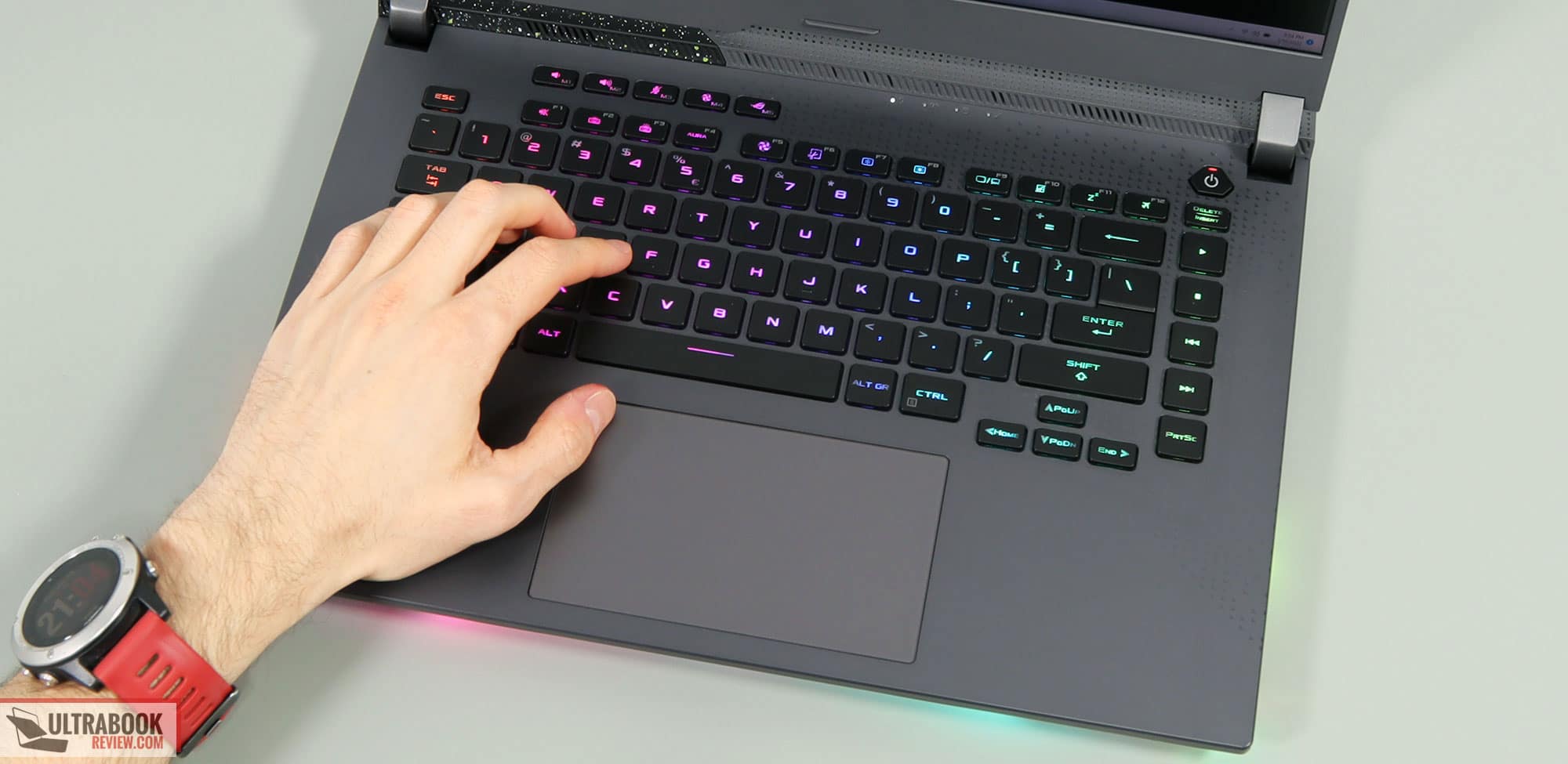
As far as the typing experience goes, this is a fine everyday typer. The keycaps are smooth and feel nice to the touch, the stroke depth is just right, and the feedback is pretty good, although a dat mushy. It does allow for fast typing speeds and quiet actuations.
The keys are RGB backlit, with per-key control and various effects selectable in the Armoury Crate and Aura Creator control apps. The LEDs are bright and uniform, with some light creeping from underneath the keycaps from a steeper angle, but not in a way that you’ll find bothering with daily use.
The F1-F12 writing on the top keys is not still not lit on this implementation, making them difficult to figure out in the dark – I sure wish Asus would address this aspect, as it’s something I’ve been complaining about on many ROG products over the years.
For mouse, the laptop implements a large glass clickpad centered in the middle of the chassis. It’s spacious, smooth to the touch, and reliable with daily use. The surface still rattles a little bit when tapped firmer, but the physical clicks are quieter and smoother than on the Scars tested a few weeks ago, so expect a degree of variation on these clickpads.
As a side note, this gray clickpad on the Strix G15 series doesn’t show off smudges as badly as the black variant available on the Scars. It’s a small detail, but with a noticeable impact during use.
As for biometrics, there are still none on this 2022 ROG Strix G15.
Screen
Asus offers two screen options for this 2022 ROG Strix G15 series, all 15.6-inch, 16:9, matte and non-touch:
- FHD 300Hz 3ms with 300+ nits of brightness and 100% sRGB colors;
- QHD 240Hz 3ms with 300+ nits of brightness and 100% DCI-P3 colors.
These are the same options offered on the 15-inch Scars as well, but the exact panels are actually a little different. We have the QHD Chi Mei panel option on this unit, while the FHD is included on the lower-tier configurations with the RTX 3060 dGPU.
This is a very good panel by today’s standards, aside from the fact that it doesn’t get very bright and it would require calibrating for professional use. I found it excellent for daily and creative use, thanks to the wide gamut coverage and good color accuracy. This is also a solid option for gaming, with fast refresh rates and response times; there’s no GSync implemented, only Adaptive-Sync to prevent tearing.
Here’s what we got in our tests, with an X-Rite i1 Display Pro sensor:
- Panel HardwareID: Chi Mei CMN1540 (NE156QHM-NZ2);
- Coverage: 99.7% sRGB, 81.4% AdobeRGB, 97.1% DCI-P3;
- Measured gamma: 2.13;
- Max brightness in the middle of the screen: 315.57 cd/m2 on power;
- Min brightness in the middle of the screen: 14.69 cd/m2 on power;
- Contrast at max brightness: 1074:1;
- White point: 7600 K;
- Black on max brightness: 0.29 cd/m2;
- PWM: No.
These findings are about on par with he BOE QHD panel on the Scar 15, but with slightly lower max-brightness and contrast.
You’ll need to calibrate this for color-accurate work, as the Gamma and White Point are skewed out of the box. Once calibrated, this ended up uniform in luminosity and color, and I also haven’t noticed any obvious screen-bleeding. In fact, the uniformity of this Chi Mei panel is superior to the QHD BOE options in the Scar series. Nonetheless, if you’re getting this for color-accurate work, make sure to properly test it with a calibration tool.
The FHD panel available for this series is about the same brightness and contrast, with slightly faster response times, but only 100% sRGB colors. It’s not going to look as nice, but it’s a fair panel for a mid-range configuration without any major compromises.
Hardware and performance
Our test model is a higher-specced configuration of the ASUS ROG Strix G15, code name G513RW, built on an AMD Ryzen 9 6900HX processor, 16 GB of DDR5-4800 memory in dual channel, 2 TB of fast SSD storage, and dual graphics: the Nvidia RTX 3070Ti dGPU with 8 GB of vRAM and the Radeon 680M iGPU integrated within the AMD processor.
Disclaimer: Before we proceed, keep in mind that our review unit was sent over by Asus and it runs on the software available as of mid-March 2022 (BIOS 310, Armoury Crate 5.0.23.0, GeForce 511.79 drivers). This is a fairly mature software package, but some aspects might still change with later updates.
Spec-wise, the 2022 ASUS ROG Strix G15 series is built on the latest AMD and Nvidia hardware available to date. The Ryzen 9 6900HX is an AMD Rembrandt 6000 processor, with 8 Cores and 16 Threads. It’s a revision of the Ryzen 9 5900Hx from last year, built on the updated Zen3+ 6 nm technology, with improvements in design, IPC, and efficiency. At its core, though, the Ryzen 9 6900HX is an incremental update of the 5900HX available in the 2022 ROG models.
The design of this Strix allows the processor to run at 90W of sustained power in demanding CPU loads, ensuring pretty much the maximum multi-threaded performance that the AMD platform is capable of. We’ll get to that in a bit.
For the GPU, the 2022 Strix G series is available with RTX 3000 and RTX 3000 Ti graphics chips. What we have on this sample is the RTX 3070Ti running at up to 150W with Dynamic Boost in supported games and applications.
For the RAM and storage options, the laptop offers two accessible memory DIMMs and two M.2 SSD slots. Our unit shipped with 16 GB of DDR5-4800 RAM in dual-channel and a middling PCIe 4.0 Micron 2450 SSD.
Accessing the components requires removing the back panel, which is held in place by a couple of Philips screws. Be extra careful when you take it out, as the panel is attached to the mainboard by two ribbons that power the LED strips. Pulling too hard might cause those to disconnect – no worries if that happens, you’ll just need to reslot the connectors in their place.
Inside you’ll find all the components, the big battery, and the thermal module. Everything is packed tightly on this compact 15-inch chassis, without any space left unused.
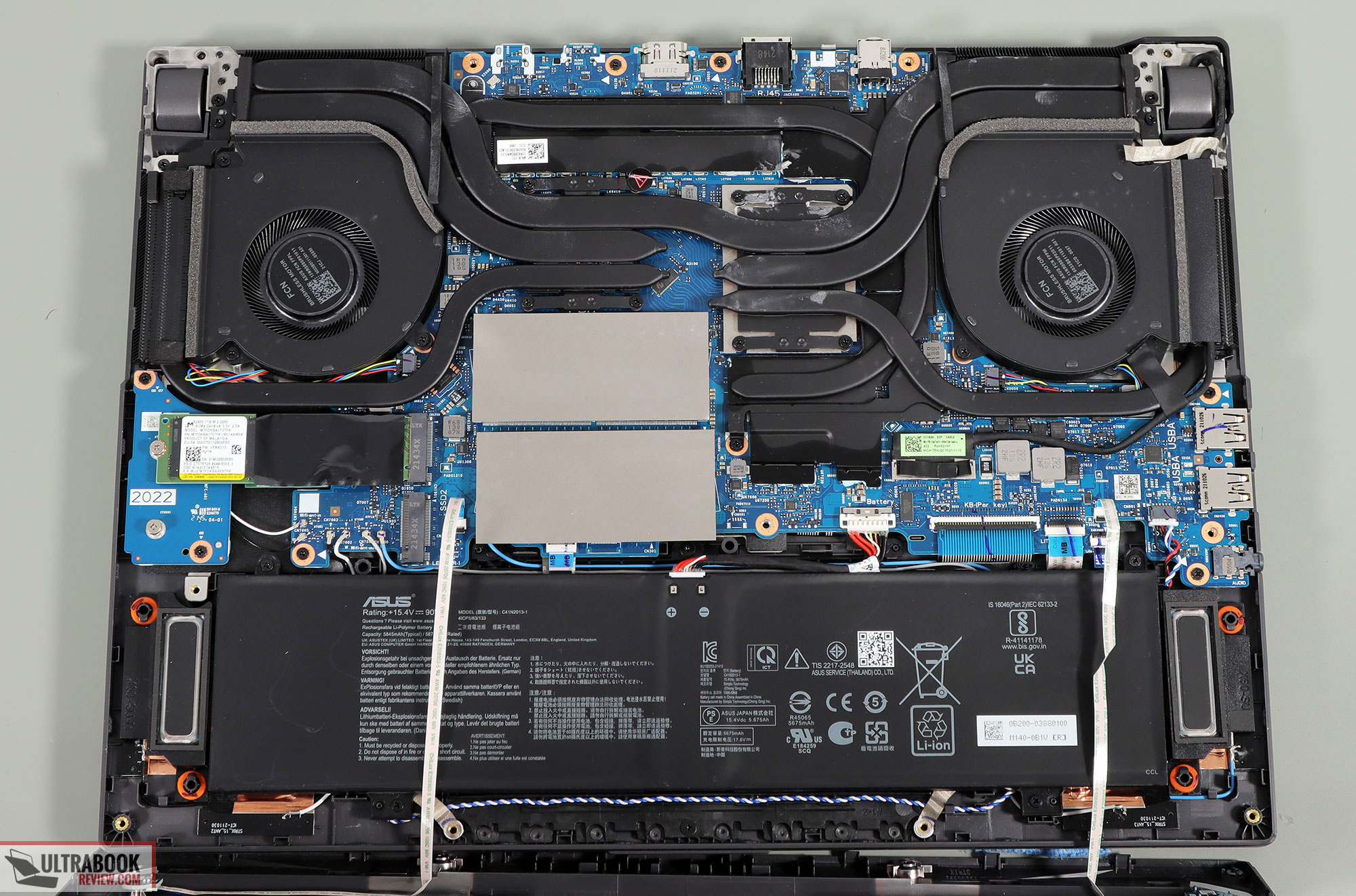
Specs aside, Asus offer the standard four power profiles in the Armoury Crate control app for this laptop: Silent, Performance, Turbo, and Manual, with various power settings and fan profiles between them:
- Silent – quite fan-noise at under 35 dB, limited CPU/GPU speeds and power;
- Performance – balanced profile with stock CPU/GPU settings and 40 dB max fan noise;
- Turbo – High-Performance profile with increased CPU power allocation, faster-spinning fans at up to 48 dB, and overclocked GPU (+50 MHz Core/+100 MHz Memory, up to 150W TGP).
- Manual – like Turbo, but with the ability to custom tweak the CPU’s PL1/PL2 power levels and GPU’s power/clocks, plus create custom fan profiles based on temperature limits.
Turbo is only available with the laptop plugged into the wall and are meant for gaming and other demanding loads. Performance is a jack-of-all-trades, while Silent is made for light daily use. The system is able to idle the fans on the Silent profile as long as the CPU/GPU stay under 60 degrees C, leading to a mostly noiseless daily-use experience.
Here’s what to expect in terms of performance and temperatures with everyday multitasking, browsing, and video.
Performance and benchmarks
On to more demanding loads, we start by testing the CPU’s performance by running the Cinebench R15 test for 15+ times in a loop, with a 1-2 seconds delay between each run.
The Ryzen 9 processor stabilizes at ~90W of sustained power on the Turbo setting, which translates in frequencies of 4.4+ GHz, temperatures of ~95 C, and scores of ~2350 points. The fans spin at ~46 dB at head-level in this mode. The CPU is minimally thermally limited on this profile.
There’s no undervolting option in the BIOS, so there’s no way to tweak the CPU at this point.
However, I did test a Manual profile with the fans pushed all the way to max rpms and the bottom of the laptop slightly raised from the desk, to favor better airflow into the fans. This results in the CPU running at between 90-100W of sustained power, 4.5 GHz and temperatures of 92-93C, with scores of 2400 points. This is the maximum you can expect from the AMD Ryzen 9 6900HX platform in this sustained test.
Switching over to the Performance profile translates in the CPU stabilizing at ~70W and temperatures still in the mid-90s, but with the fans spinning much quieter at only ~35 dB at head-level. The CPU is power and thermally limited in this mode, but still returns scores of ~2250 points, just 5% lower than on Turbo and 7% lower than on Manual.
The Silent profile limits the sustained power at 45W, with barely audible fans (sub 32 dB) and middling temperatures (mid-70s C). The Ryzen 9 still scores ~2000 points in the Cinebench test, roughly 80-85% of the Turbo performance, which is excellent for this kind of a profile, and showcases the AMD platform’s efficiency and capabilities at lower power settings.
Finally, the CPU runs at ~35 W on battery, on the Performance profile, with stabilized scores of around 1900+ points once the fans start spinning (they keep idle for the first loops). Details below.
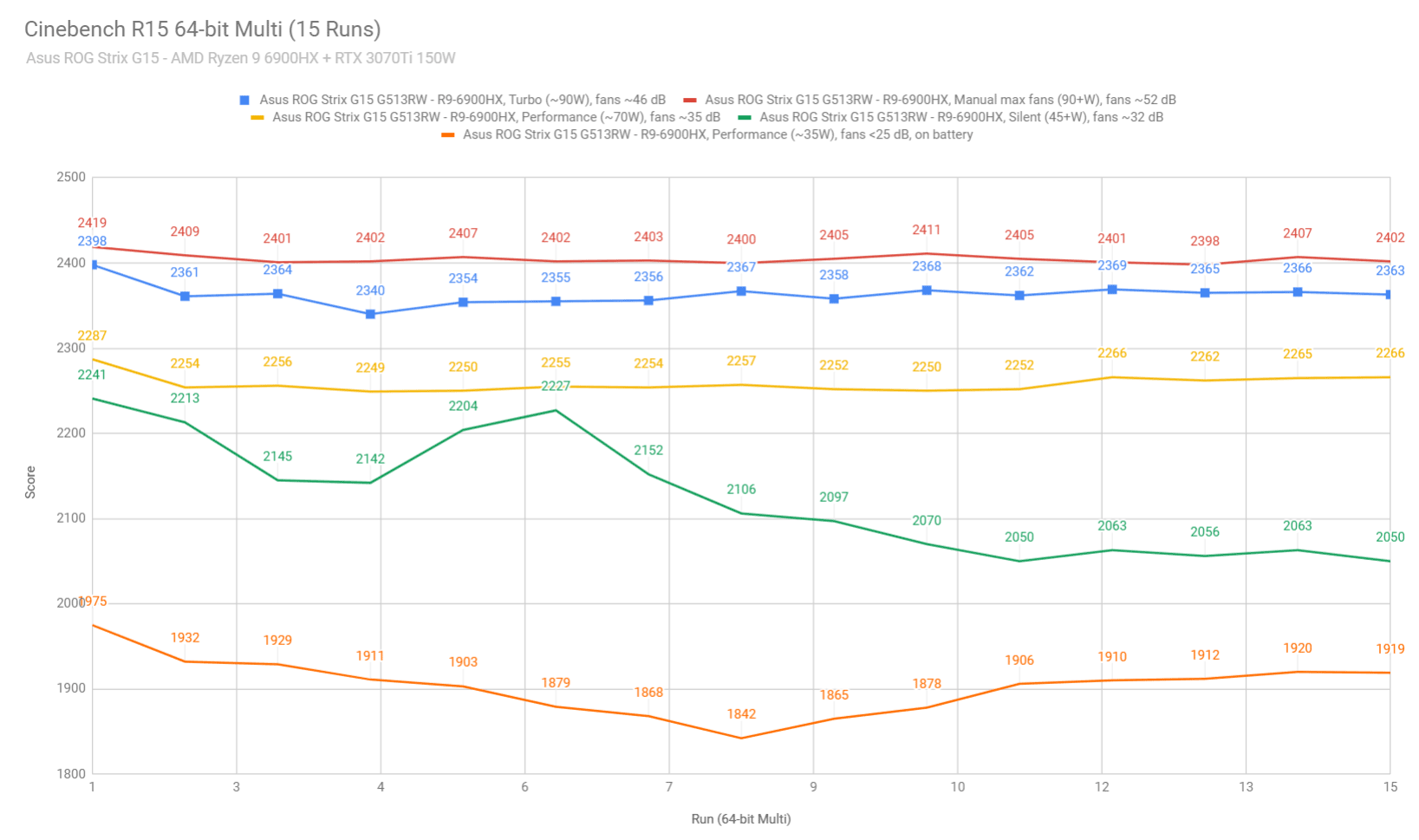
To put these in perspective, here’s how this Ryzen 9 6900HX implementation fares against other implementations in this test, both Intel and AMD. The 2022 Intel i9-12900H ends up about 20% faster, but the 2022 Ryzen 9 6900HX outscores the Intel and AMD 2021 platforms at similar power by 5-10%. A more detailed comparison between the AMD Ryzen 9 6900HX and Intel Core i9-12900H platforms is available here.
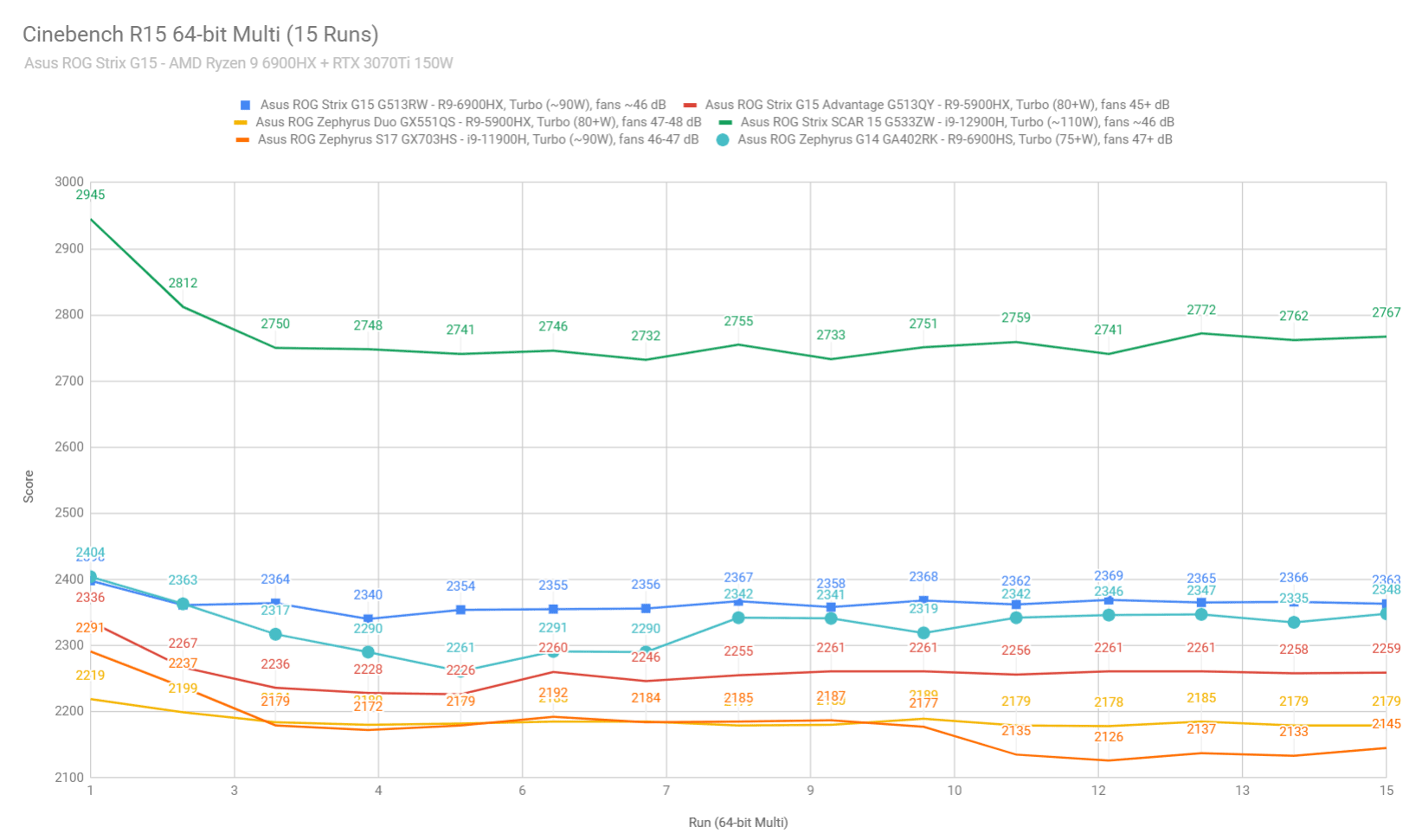
We also ran the 3DMark CPU test on the Turbo, Performance, and Silent profiles.
We then went ahead and further verified our findings with the more taxing Cinebench R23 loop test and Blender – Classroom, which resulted in similar findings to what we explained above.
Finally, we ran our combined CPU+GPU stress tests on this notebook. 3DMark stress runs the same test for 20 times in a loop and looks for performance variation and degradation over time, and this unit passed it just fine, which means there’s no performance throttling with longer-duration sustained loads.
Next, we ran the entire suite of tests and benchmarks, on the stock Turbo profile in Armoury Crate, the MUX set on Hybrid mode, and on FHD screen resolution for consistency with our other tests.
- 3DMark 13 – Fire Strike: 26301 (Graphics – 30038, Physics – 26998, Combined – 13339);
- 3DMark 13 – Port Royal: 6898;
- 3DMark 13 – Time Spy: 11039 (Graphics – 11121, CPU – 10602);
- Uniengine Superposition – 1080p Extreme: 7284;
- Uniengine Superposition – 1080p Medium: 22312;
- Handbrake 1.3.3 (4K to 1080p encode): 51.89 average fps;
- PassMark 10: Rating: 7734 (CPU mark: 26635, 3D Graphics Mark: 23608, Disk Mark: 16263);
- PCMark 10: 7602 (Essentials – 10560, Productivity – 9891, Digital Content Creation – 11414);
- GeekBench 5.4.3 64-bit: Single-Core: 1546, Multi-core: 9566;
- CineBench R15 (best run): CPU 2303 cb, CPU Single Core 246 cb;
- CineBench R20 (best run): CPU 5662 cb, CPU Single Core 606 cb;
- CineBench R23: CPU 14450 cb (best single run), CPU 14187 cb (10 min run), CPU Single Core 1553 cb;
- x265 HD Benchmark 64-bit: 25.87 s.
Compared to the i9 + RTX 3070Ti 150W configuration in the very similar ROG Scar 15 design, this 2022 Strix G15 ends up within 10-20% slower in the CPU multi-core tests, and 20+% slower in the single-core CPU loads.
The GPU performance, on the other hand, is pretty much identical between the two in these synthetic tests, which shouldn’t be a surprise, as the two ROG models implement the exact same RTX 3070Ti running at up to 150W.
At the same time, compared to the 2021 Ryzen 7 + RTX 3070 130W in the Strix G17 reviewed here, the 2022 model is 7-15% faster in the CPU tests, and about 15-20% faster in the GPU benchmarks. Furthermore, compared to the Strix G15 Advantage Edition with the Ryzen 9 and RX 6800M dGPU running at 165W, this 2022 model still ends-up about 10% faster in the CPU loads, and roughly similar in performance in the GPU tasks, but with ample variations in results between the different loads.
Next, here are some workstation benchmarks, on the same Turbo profile:
- Blender 3.01 – BMW scene – CPU Compute: 2m 47s (Turbo);
- Blender 3.01 – BMW scene – GPU Compute: 20s (CUDA), 11s (Optix);
- Blender 3.01 – Classroom scene – CPU Compute: 6m 12s (Turbo);
- Blender 3.01 – Classroom scene – GPU Compute: 39s (CUDA), 25s (Optix);
- Pugetbench – DaVinvi Resolve: 1040;
- Pugetbench – Adobe Afert Effects: 824;
- Pugetbench – Adobe Photoshop: 919;
- Pugetbench – Adobe Premiere: 719;
- SPECviewperf 2020 – 3DSMax: 109.83 (Turbo);
- SPECviewperf 2020 – Catia: 67.44 (Turbo);
- SPECviewperf 2020 – Creo: 94.34 (Turbo);
- SPECviewperf 2020 – Energy: 23.6 (Turbo);
- SPECviewperf 2020 – Maya: 401.48 (Turbo);
- SPECviewperf 2020 – Medical: 33.39 (Turbo);
- SPECviewperf 2020 – SNX: 20.78 (Turbo);
- SPECviewperf 2020 – SW: 263.68 (Turbo).
- V-Ray Benchmark: CPU – 10574 vsamples, GPU CUDA – 1248 vpaths, GPU RTX – NA;
In these tests, the Intel Core i9 2022 ROG variant maintains the 10-20% advantage in the CPU-heavy loads, as well as a more notable advance in some of the Adobe applications such as Premiere, which benefits from Quik Sync support.
The performance in the GPU heavier loads such as Maya, 3DS Max or Solidworks is once more on par between the AMD and Intel platforms, and superior to the 2021 Strix G15 models, both the Nvidia 3070 and the AMD RX 6800M configurations.
These aside, you should keep in mind that the laptop runs averagely loud on this Turbo profile, at somewhere around 45-49 dB between loads. In comparison, the Intel Scar 15 variant runs at a more stable level at 48 dB in all loads.
Now, if you prefer sacrificing the performance to some extent for quieter fan noise, here’s how this 2022 Strix G15 does on the Performance profile, which limits the fans to somewhere between 35-40 dB at head level.
- 3DMark 13 – Fire Strike: 23927 (Graphics – 26804, Physics – 25799, Combined – 12504);
- 3DMark 13 – Time Spy: 9716 (Graphics – 9840, CPU – 9073);
- Uniengine Superposition – 1080p Extreme: 6627;
- GeekBench 5.4.3 64-bit: Single-Core: 1538, Multi-core: 9221;
- CineBench R20 (best run): CPU 5118 cb, CPU Single Core 598 cb.
The overall performance takes a rather minor ~10-15% hit on this mode, but the internal components end up hotter than on the Turbo mode, as a result of still running at high power and with more limited fan airflow. That means I wouldn’t recommend running sustained demanding chores on this Performance mode on a daily basis.
You can opt for the Silent profile, though, in which case the fans won’t go over 35 dB. Here’s what we got in this case:
- 3DMark 13 – Fire Strike: 11993 (Graphics – 11254, Physics – 18900, Combined – 11369);
- 3DMark 13 – Time Spy: 4667 (Graphics – 4272, CPU – 9821);
- Uniengine Superposition – 1080p Extreme: 2747;
- GeekBench 5.4.3 64-bit: Single-Core: 1544, Multi-core: 9434;
- CineBench R20 (best run): CPU 5235 cb, CPU Single Core 594 cb.
The CPU is still a competitive performer on this profile, running within 10-20% of what it can do on Turbo. However, the GPU is significantly limited at about 40% of its capabilities on Turbo. Both components run at adequate temperatures in the 70s, though, so the laptop is safe to use on this mode for longer sustained activities. Up to you if the performance/noise balance is justifiable on this Silent profile.
Gaming performance
As a member of the ROG -Republic of Gamers family of laptops, the ROG Strix G15 is primarily a gaming computer, so let’s see how it handles modern titles.
We tested several games at QHD and FHD resolution on Ultra settings, on the stock Turbo and Performance profiles, but also on a Manual mode with maxed-out fans and a few tweaks that I’ll explain further down. I’ve also included the Silent mode in the tables, for a better picture of what you can expect if you’re after a silent gaming experience on this computer.
Here are the raw numbers, all these with the MUX set on the Discrete GPU mode:
Ryzen 9 6900HX
+ RTX 3070Ti Laptop 125-150W
QHD Turbo
QHD Manual
QHD Performance
FHD Turbo
FHD Silent
Battlefield V
(DX 12, Ultra Preset, RTX OFF)
118 fps (64 fps – 1% low)
129 fps (81 fps – 1% low)
111 fps (61 fps – 1% low)
152 fps (51 fps – 1% low)
60 fps (57 fps – 1% low)
Cyberpunk 2077
(DX 12, Ultra Preset, RTX OFF)
45 fps (35 fps – 1% low)
49 fps (37 fps – 1% low)
42 fps (32 fps – 1% low)
66 fps (54 fps – 1% low)
–
Doom Eternal
(Vulkan, Ultra Preset)
186 fps (141 fps – 1% low)
–
165 fps (32 fps – 1% low)
241 fps (168 fps – 1% low)
–
Far Cry 6
(DX 12, Ultra Preset, TAA)
79 fps (43 fps – 1% low)
81 fps (55 fps – 1% low)
75 fps (42 fps – 1% low)
85 fps (55 fps – 1% low)
–
Far Cry 5
(DX 11, Ultra Preset, SMAA)
106 fps (78 fps – 1% low)
107 fps (80 fps – 1% low)
98 fps (58 fps – 1% low)
124 fps (93 fps – 1% low)
60 fps (58 fps – 1% low)
Metro Exodus
(DX 12, Ultra Preset, RTX OFF)
65 fps (45 fps – 1% low)
–
–
81 fps (51 fps – 1% low)
–
Red Dead Redemption 2
(DX 12, Ultra Optimized, TAA)
85 fps (58 fps – 1% low)
–
–
108 fps (72 fps – 1% low)
–
Shadow of Tomb Raider
(DX 12, Highest Preset, TAA)
96 fps (68 fps – 1% low)
99 fps (70 fps – 1% low)
88 fps (65 fps – 1% low)
119 fps (76 fps – 1% low)
60 fps (52 fps – 1% low)
The Witcher 3: Wild Hunt
(DX 11, Ultra Preset, Hairworks On 4)
106 fps (85 fps – 1% low)
108 fps (86 fps – 1% low)
95 fps (76 fps – 1% low)
136 fps (76 fps – 1% low)
46 fps (35 fps – 1% low)
- Battlefield V, Cyberpunk, Doom, Witcher 3 – recorded with Fraps/in-game FPS counter in campaign mode;
- Far Cry 5, 6, Metro, Red Dead Redemption 2, Tomb Raider games – recorded with the included Benchmark utilities;
- Red Dead Redemption 2 Optimized profile based on these settings.
Those above are rasterization tests, and here are some results for RTX titles with and without DLSS.
AMD Ryzen 9 6900HX
+ RTX 3070Ti Laptop 125-150W
QHD Turbo
FHD Turbo
Battlefield V
(DX 12, Ultra Preset, RTX ON, DLSS OFF)
112 fps (91 fps – 1% low)
98 fps (69 fps – 1% low)
Battlefield V
(DX 12, Ultra Preset, RTX ON, DLSS ON)
85 fps (69 fps – 1% low)
112 fps (88 fps – 1% low)
Cyberpunk 2077
(DX 12, Ultra Preset + RTX, no DLSS)
16 fps (11 fps – 1% low)
33 fps (26 fps – 1% low)
Cyberpunk 2077
(DX 12, Ultra Preset + RTX, DLSS Balanced)
48 fps (40 fps – 1% low)
70 fps (56 fps – 1% low)
Doom Eternal
(DX 12, Ultra Preset, RTX ON, DLSS Quality)
138 fps (102 fps – 1% low)
191 fps (135 fps – 1% low)
Far Cry 6
(DX 12, Ultra Preset + DXR reflections / shadows)
66 fps (39 fps – 1% low)
70 fps (48 fps – 1% low)
Shadow of Tomb Raider
(DX 12, Highest Preset, TAA, RTX Ultra)
58 fps (41 fps – 1% low)
77 fps (46 fps – 1% low)
In broader terms, the Intel i9-12900H Scar 15 configuration ends up outscoring this AMD Ryzen 9 6900HX configuration by between 0-15% in the tested games, both with the exact same RTX 3070Ti GPU running at up to 150W with Dynamic Boost. The results vary, though, as some games are running competitively on the AMD laptop, such as Cyberpunk or Metro, but others are noticeably faster on the Intel model, such as Witcher 3 or Battlefield V.
These differences are partially explained by the higher-thermals on the AMD model, as a result of the slight difference in thermal paste between the Scar 15 and the Strix G15 series, but primarily by the differences in how Dynamic Boost works on this AMD model vs the Intel variant reviewed a few weeks ago. We’ll discuss this in a bit.
At the same time, compared to the 2021 Ryzen 7 + RTX 3070 130W Strix G implementations, the 2022 model ends up 5-20% faster at QHD resolution and 7-25% better at FHD, where the higher power GPU and especially the MUX available with this generation play a greater role.
With these out of the way, let’s go over some performance and temperatures logs, which are going to better explain some of our findings above.
On Turbo and with the current BIOS settings, this laptop runs the CPU at high power settings of 35-55W, and that is impacting the amount of power allocated to the GPU, and thus the overall GPU performance. The design allows up to 179W of combined CPU+GPU power in games and demanding loads, on this Turbo profile.
With Battlefield V, for instance, which is known not to work very well with Dynamic Boost 2.0, the CPU runs at 55W and thus the GPU only runs at 125W. Hence, the fps difference between this Strix 15 and the Scar 15. In Cyberpunk 2077, the CPU runs at 35-40W, and the GPU at around 140-145W. Even so, the Intel CPU runs at 25-30W in the Scar 15 implementation in the same game, and that allows the GPU to run closer to its design maximum of 150W.
Check out of the logs for more details.
Now, Asus might tweak the power settings with a future BIOS update, limiting the CPU allocated power and favoring the GPU. If they do that, the overall gaming performance should increase by as much as 10% in titles such as Battlefield V or Far Cry 5, which are CPU heavier and don’t normally scale well with Dynamic Boost. That will impact the CPU/GPU temperatures, though.
With the current settings, the AMD CPU runs at about 80-90 degrees Celsius on Turbo, while the GPU runs in the low to mid-80s. The higher the power, the higher the temperatures, and vice versa. Overall, this is a rather toasty running notebook and marginally hotter than the Intel-based Scar 15, especially on the CPU side. It also runs a little bit noisier on Turbo, at 49-50 dB.
Bumping the back of the laptop from the desk in order to improve the airflow helps shed 2-4 degrees off the components. That’s because the low-profile rubber feet implemented on this laptop choke the intakes to some extent. We noticed the same behavior on the Scar 15/17 series, which implement the same cooling and rubber feet.
Then I moved on to the Manual mode which allows customizing the fan profiles and CPU/GPU settings. Since most of you were interested in how the laptop does at max fans, I’ve set them at 100% in this case, as well as applied these CPU and GPU settings:
- CPU: PL1 limit at 35W (to encourage power shifting to the GPU), fan set at 100% rpm for temperatures over 50C.
- GPU: the same +50MHz Core and +100 MHz memory overclock (there’s room for further tweaking here), fan set at 100% for temperatures over 50C.
These settings push up the laptop to run noisier, at 52 dB at head-level with both fans ramped to 100% speeds.
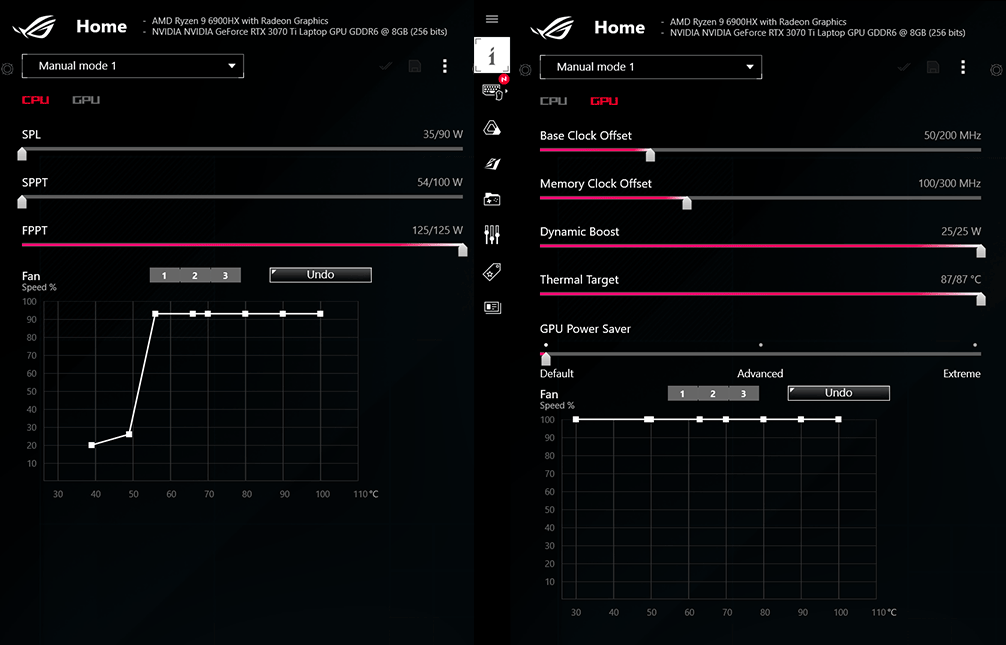
As far as the performance goes, this Manual profile impacts those titles that previously ran the CPU at higher power (and the GPU at lower power), such as Battlefield V. The impact over the framerates is otherwise minimal in the other games, and I’ll add that even with the 35W CPU limit, the GPU only runs at around 145W of power, and not up to its full 150W potential, as a result of the 179W combined power limit. The CPU would need to run somewhere at sub 30W for max GPU performance.
The impact over the CPU/GPU temperatures is noticeable on this Manual mode, though, somewhere between 2-6 degrees C.
Bumping the back of the laptop from the table helps even more, shaving off 1-4 extra degrees C from the components compared to the on-desk Manual mode. In this case, the CPU ends up averaging between 75-85s C, and the GPU around 78-82s C. Both are fine temperatures for a 15-inch gaming laptop of this generation.
One other aspect this Manual mode allows is to set a GPU thermal limit and the system will adjust the GPU frequencies and power to make sure the chip doesn’t go above that. I haven’t tested this here, but I did test an 80 degrees GPU limit in the Scar reviews, if curious.
With all these high-performance profiles out of the way, if you’re looking for quieter noise levels when running games, your options are either the Performance mode or the Silent mode, or a further tweaked Manual profile.
On Performance, the fans spin much quieter at around 40 dB, and the framerates only take a ~10% hit compared to the Turbo mode. However, the internal components end up running at higher temperatures than on Turbo. Games are still going to run fine on this profile, but you’ll have to accept CPU temperatures in the 90s, GPU temperatures in the 85-87 C and GPU power throttling in most titles, as well as somewhat higher surface temperatures than on the Turbo mode.
The Silent mode aggressively limits the GPU on this laptop, leading to CPU/GPU temperatures of 65-75 C and fan noise levels of sub 35 dB.
Most games are still going to run OK with Whisper Mode activated and a 60 fps limit. You’ll want to opt for FHD Ultra or QHD Medium settings in this case, though, as you’re not going to get playable framerates at QHD Ultra with modern titles.
Lastly, this laptop can also run games on battery on the Performance profile, with a 60 fps limit set in the settings. It performs much as on the Silent plugged-in mode detailed above. Don’t expect more than one hour of gameplay at full details, or perhaps longer with a 30 fps cap and lower settings.
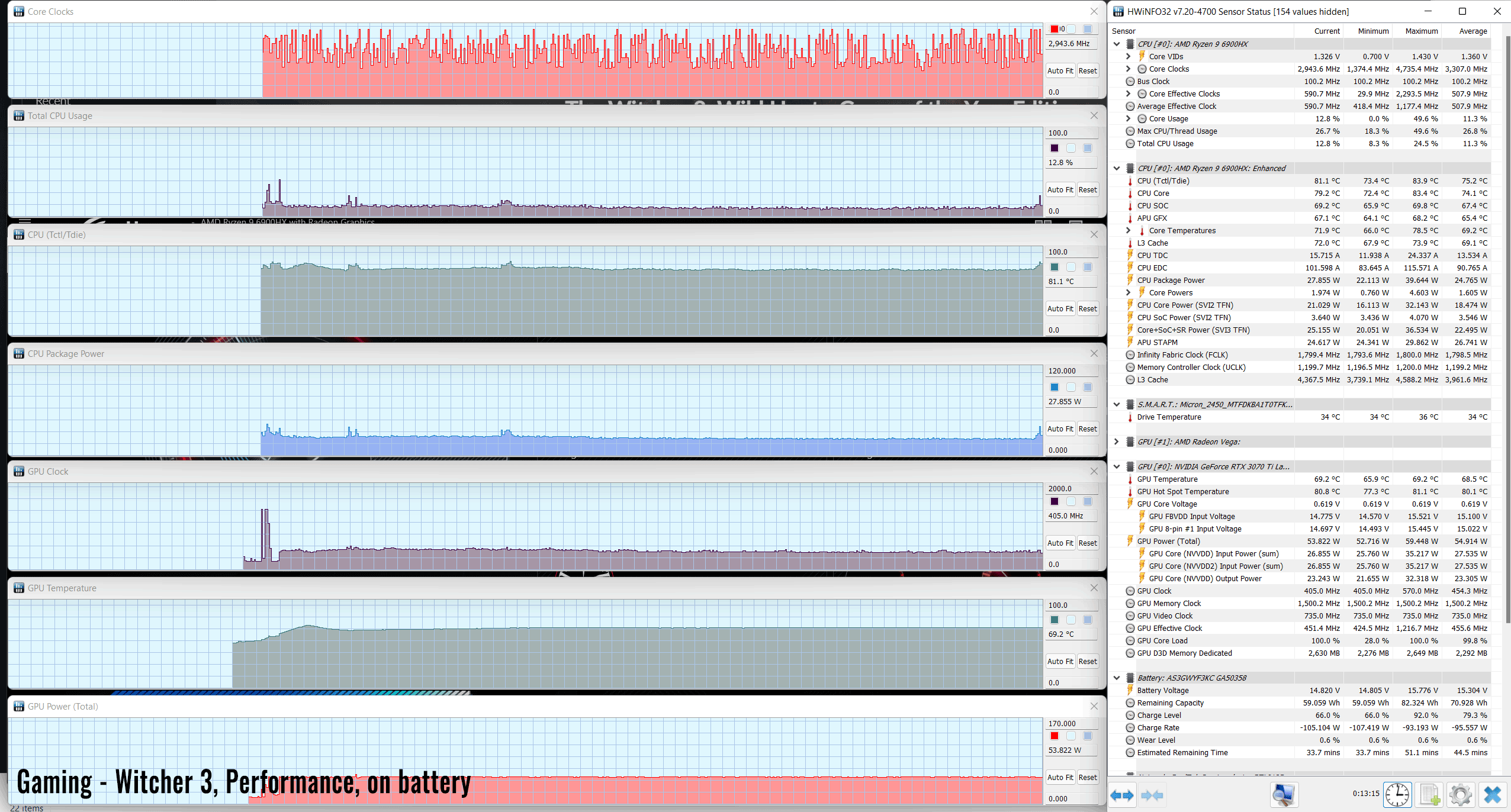
All in all, this AMD-based 2022 Asus ROG Strix G15 series is a very capable performer and a 5-25% step-up from the 2021 implementations, thanks to the updated hardware, the bump in power and the addition of the MUX.
The AMD Rembrandt 6000 platform is no longer a match for the Intel 12th gen Alder Lake hardware in either fast single-core or demanding multi-threaded loads, though. That’s not going to have a major impact over the gaming performance, although the Intel configurations tend to do better in this case as well, but will impact the overall performance in sustained workloads.
Furthermore, this AMD model tends to run marginally hotter and noisier than the Intel-based Scar 15 tested before. The differences are minor, but are there, and they’re caused by the way the system allocates the power to the CPU/GPU on the two platforms, as well as by the slight difference in the cooling module, which favors the Scar 15 series.
Lastly, it’s important to acknowledge where the AMD platform still has a noticeable edge over the Intel hardware, and that’s in its efficiency and performance per watt. On the Silent profile, at lower power settings and noise levels, the Ryzen 9 outscores the Intel i9 in our tests, and the superior efficiency allows for better performance on battery and longer runtimes with everyday chores. We’ll further discuss these in a follow-up comparison of the Ryzen 9 6900HX and the Intel Core i9-12900H platforms, in a separate article.
Noise, Heat, Connectivity, speakers, and others
Asus implements the same thermal module on both the 2022 Scar 15 and Strix G15 series, with the same fans, heatpipes, and overall design.
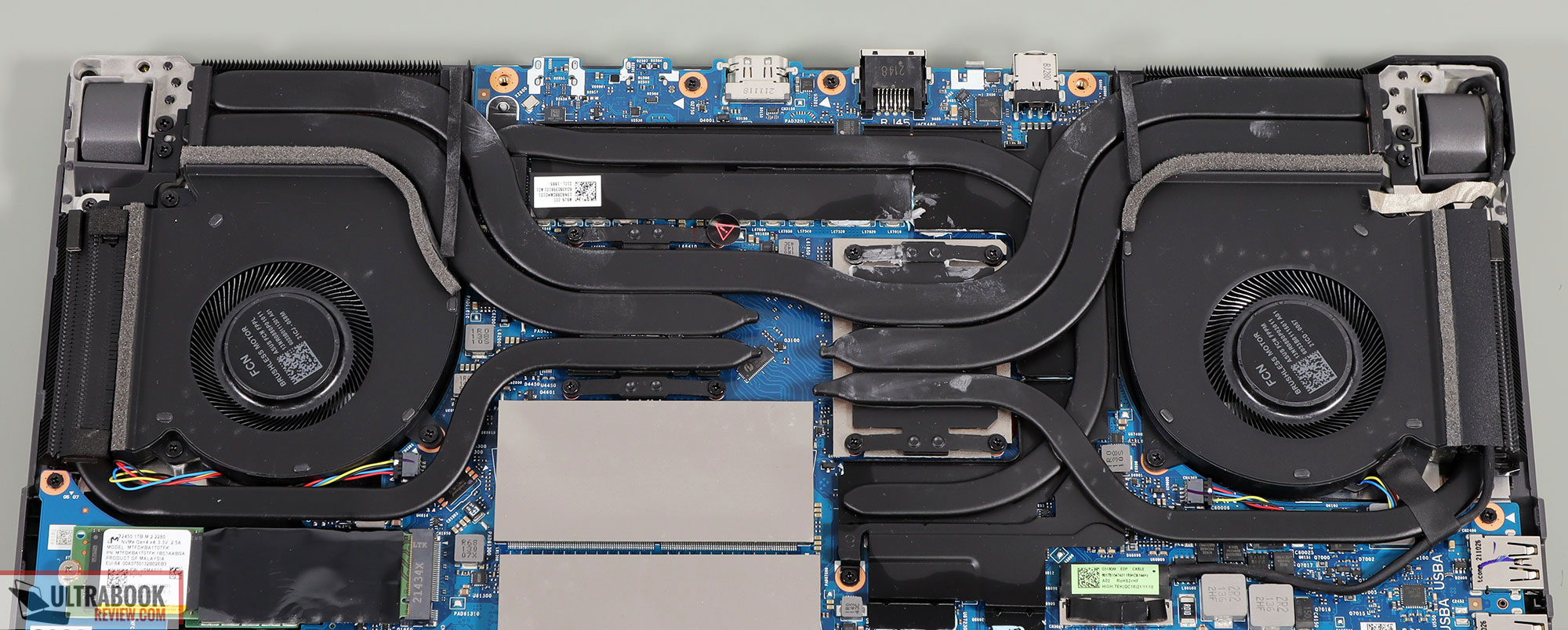
However, the Strix G15 series only gets Asus’s standard liquid-metal thermal paste on the CPU side, and not the improved Thermal Grizzly Conductonaut Extreme that’s available on the Scar 15/17 series. This impacts the CPU temperatures, in corroboration with the fact that the system runs the CPU at higher power on this AMD model compared to the Intel implementation.
So, as discussed in the previous section, the CPU and the GPU both run rather hot in the 2022 Strix G15, on the stock profiles with the laptop sitting on the desk. We’re looking at temperatures in the low to mid-80s for both, which are within expected limits for a performance laptop.
Much like the Scar series, the cooling module is still somewhat choked with this Strix G15 design by the slim rubber feet that Asus implement on the underside of this series. As a result, lifting up the back of the laptop from the desk leads to a noticeable decrease in the internal temperatures, both on the CPU and on the GPU. Ramping up the fans to max rpms in Manual mode helps lower these even further.

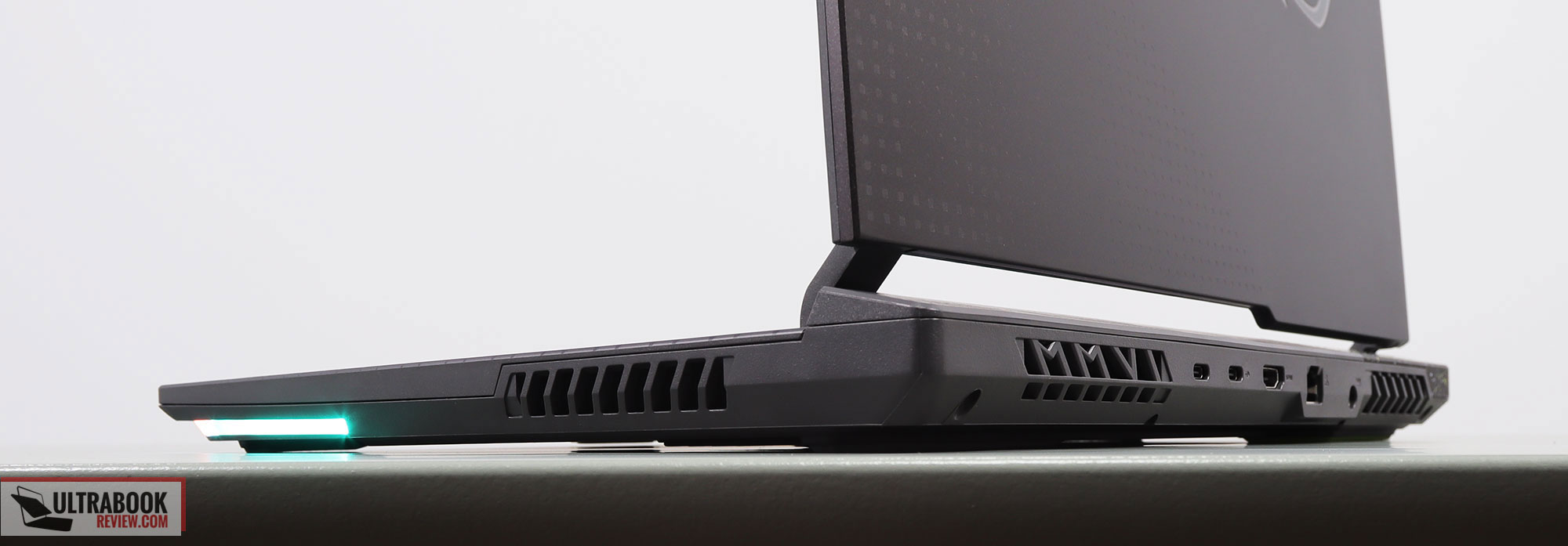
I reported similar findings on the 2021 Strix/Scars and was hoping Asus would somehow update the rubber feet for the 2022 model. They did not.
Now, as far as the outer case temperatures go, those are excellent on Turbo, where none of the areas that you’ll normally come in contact with go above 40 degrees Celsius, and only noticeably warmer on the Performance and Silent profiles.
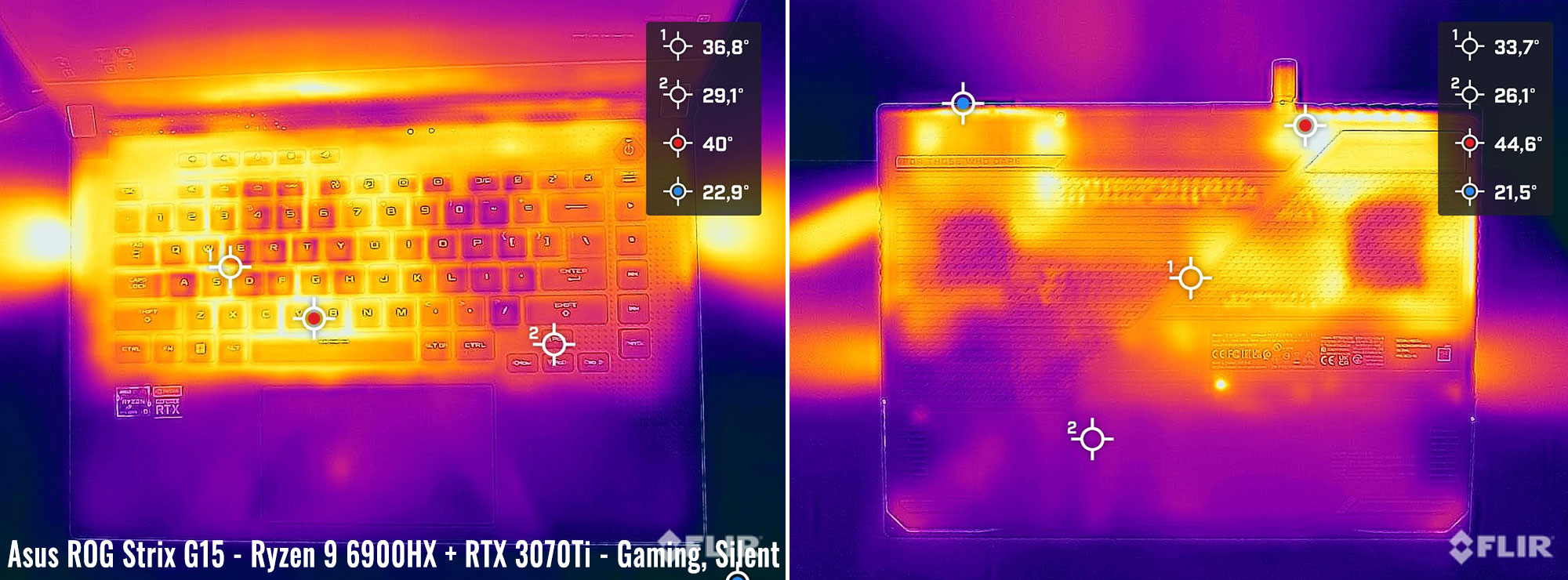
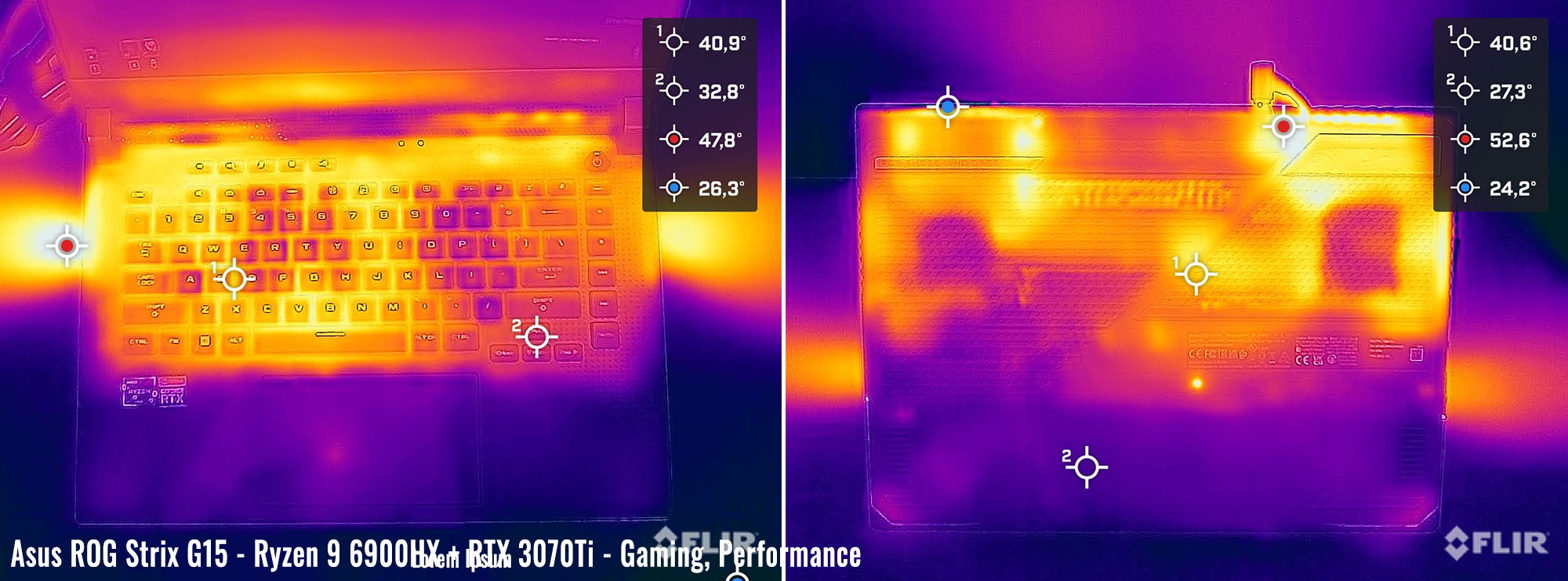
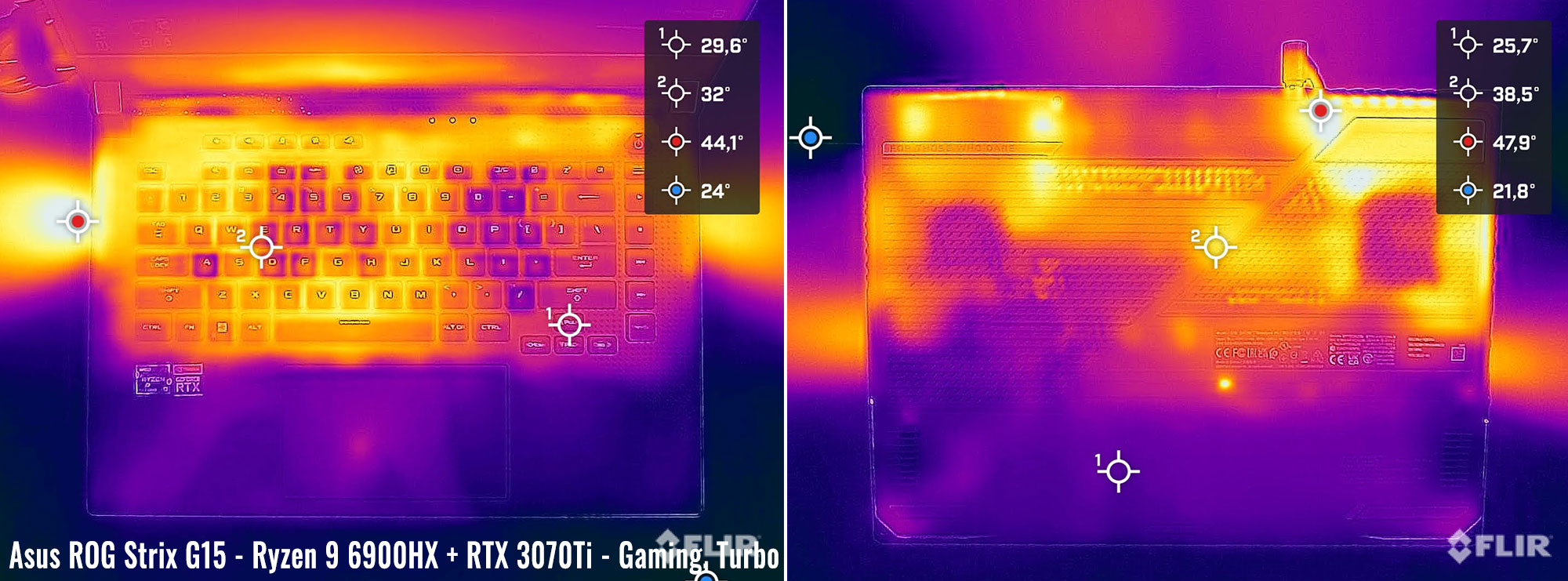
*Gaming – Silent – playing Far Cry 5 for 30 minutes, Silent profile, fans at ~35 dB
*Gaming – Performance – playing Far Cry 5 for 30 minutes, fans at ~40 dB
*Gaming – Turbo, on desk – playing Cyberpunk 2077 for 30 minutes, fans at ~49 dB
At the same time, this laptop is a breeze with everyday use, multitasking, browsing, or video streaming. The 0dB Technology allows the two fans to completely switch off with light use as long as the hardware stays under 60 C on the Silent profile, which is most of the time. And that’s both on battery or when plugged in.
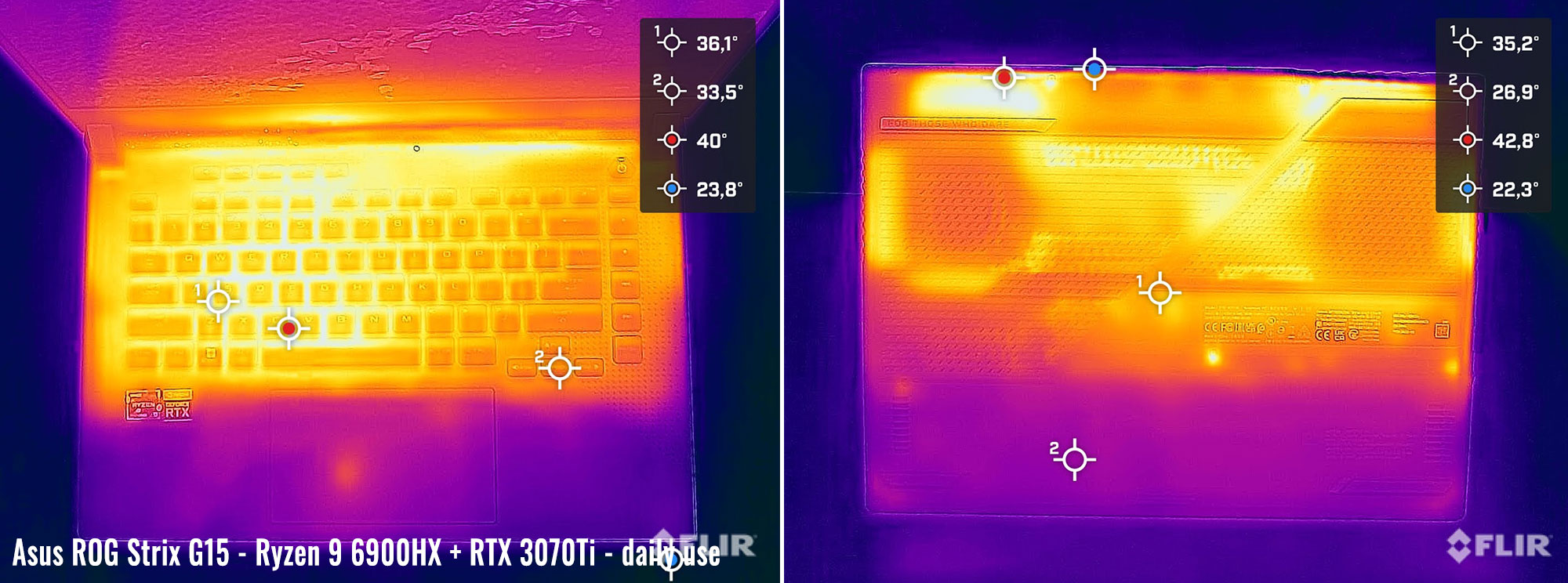
*Daily Use – streaming Netflix in EDGE for 30 minutes, Silent profile, fans at 0 dB
For connectivity, there’s Wireless 6E and Bluetooth 5 on this unit, as well as 2.5 Gigabit Lan, an update from the previous generations. Asus only equipped our sample with a Mediatek chip, which is OK for everyday use, but not as fast as the modern Intel wireless modules available these days. I can’t tell for sure what you’ll be getting on the retail units, with the current chip shortage situation – you can upgrade the included module for a faster one if you want to, as long as you’re able to find a spare.
The audio quality here is very good for laptop speakers, with two main speakers firing on the bottom and two extra tweeters firing from under the display. The sound is fairly rich and loud at 80+ dB at head level, and I haven’t noticed any annoying distortions or vibrations into the main chassis. I still recommend ticking the “Enhanced Audio” option in the Sound menu in Windows 11, it does boot the overall sound quality to a small extent.
Finally, the camera… well, there still isn’t any.
Battery life
There’s a 90Wh battery inside all the 2022 ROG models, including this Strix G15.
The system automatically switches the screen’s refresh to 60 Hz when using the laptop on battery, to increase efficiency, and that’s the quick screen flicker that you’ll notice when disconnecting the laptop from the wall. Also, if you’re looking to maximize runtimes, make sure to use the laptop in the Hybrid MUX mode.
Here’s what we got on our review unit in terms of battery life, with the screen’s brightness set at around 120 nits (~60 brightness) and on Hybrid mode.
- 15 W (~5-7 h of use) – text editing in Google Drive, Silent Mode, screen at 60%, WiFi ON;
- 10.5 W (~7-9 h of use) – 1080p fullscreen video on Youtube in Edge, Silent Mode, screen at 60%, WiFi ON;
- 9.5 W (~8-10 h of use) – Netflix fullscreen in Edge, Silent Mode, screen at 60%, WiFi ON;
- 18 W (~4-6 h of use) – browsing in Edge, Performance Mode, screen at 60%, WiFi ON;
- 85 W (~1 h of use) – Gaming – Witcher 3, Performance Mode, screen at 60%, WiFi ON, no fps limit.
In comparison, here’s what we got on last year’s AMD-based Scar 15.
- 12 W (~6-8 h of use) – text editing in Google Drive, Silent Mode, screen at 60%, Wi-Fi ON;
- 11.5 W (~8+ h of use) – 1080p fullscreen video on Youtube in Edge, Silent Mode, screen at 60%, Wi-Fi ON;
- 11 W (~8+ h of use) – Netflix fullscreen in Edge, Silent Mode, screen at 60%, Wi-Fi ON;
- 14 W (~5-6 h of use) – browsing in Edge, Balanced Mode, screen at 60%, Wi-Fi ON;
- 80 W (~1+ h of use) – Gaming – Witcher 3, Performance Mode, screen at 60%, Wi-Fi ON, no fps limit.
The differences are within the margin of error, with slightly better efficiency with video streaming for the 2022 generation. These runtimes are also much better than on the Intel-based 2022 ROG Scar series, especially with video and light use.
I’ll also add that this ROG Strix G5 G513RW configuration comes with a 280W power brick, larger and heavier than the 240W variant on the 2021 models. The battery fills up in about 2 hours, with fast charging for the first half an hour, and USB-C charging is supported, up to 100W.
You won’t be able to use the laptop on Turbo while hooked over USB-C, but that’s enough for everyday multitasking and occasional heavy workloads on Performance, in case you don’t want to bring along the heavier main brick when on the go.
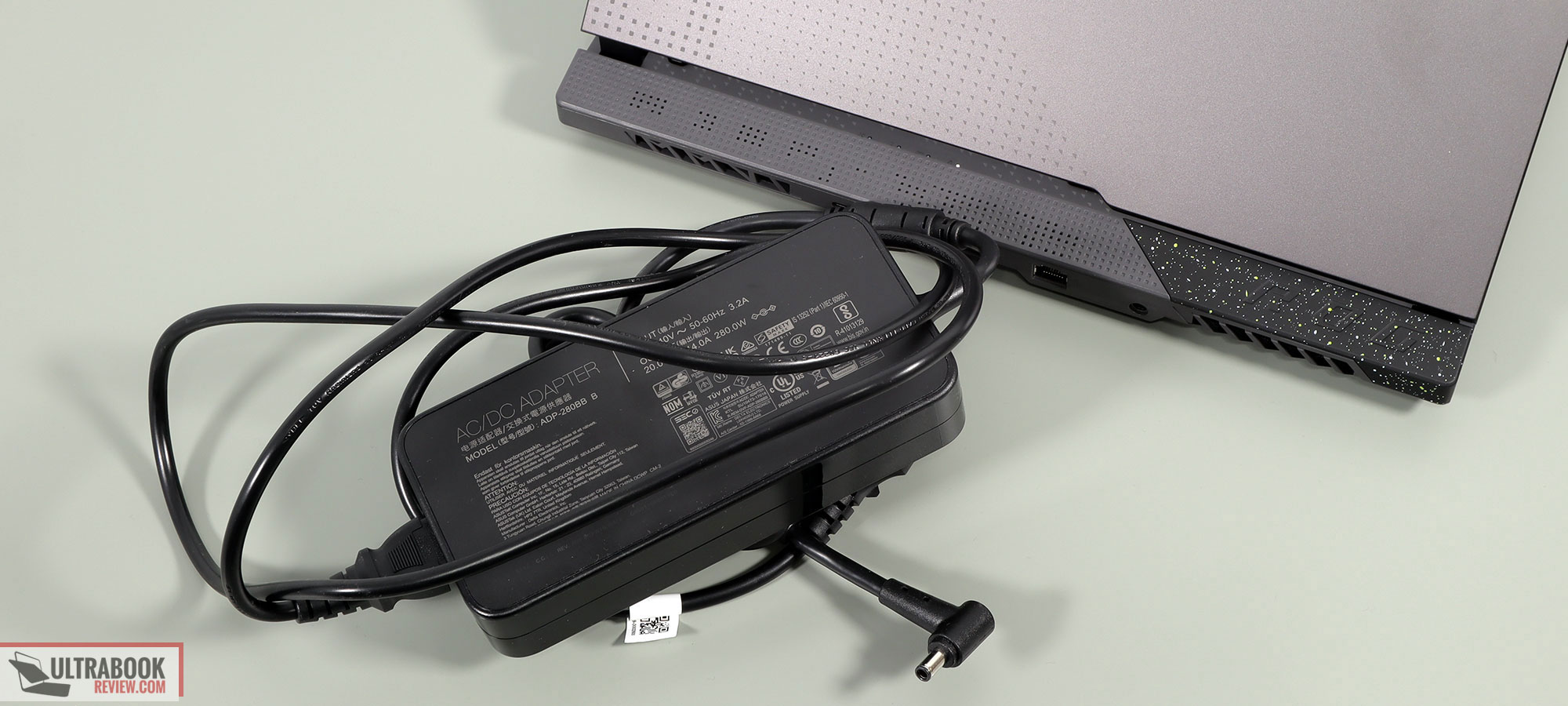
Price and availability- 2022 ASUS ROG Strix G15
The 2022 Asus ROG Strix G15 is listed in a few regions at the time of this article.
I couldn’t find this reviewed configuration in the US, with the Ryzen 9 processor and RTX 3070Ti graphics, but it is available here in Europe for around 2300-2400 EUR. That’s about 100-200 EUR less than the similarly specced ROG Scar 15.
In comparison, the Scar 15 goes for between $1800 to $4000 in the US for the various models, and I’d expect the Strix G15 to go for $200-$300 less for the same specs. That means this i9+RTX3070Ti model should be available for around $2100-$2200, with the RTX 3060 configurations starting perhaps as low as $1600.
We’ll update you when we know more. In the meantime, follow this link for updated configurations and prices in your region at the time you’re reading this article.
Final thoughts- 2022 ASUS ROG Strix G15 review
Having used this Strix G15 for the last few weeks, I consider it a slightly better value buy for the average user than the higher-tier, more powerful, and more expensive ROG Scar 15 lineup of this same generation.
The two are pretty much the same format and overall functionality, with some advantages on either side. For the Strix G15, I appreciate the gray color scheme that’s a lot friendlier with smudges and finger oil, the smaller status LEDs, and the cleaner overall design. Not a fan of the panel-lid ROG logo on the lid, though, or the dumbed-down IO without HDMI 2.1 and with a single USB-C port with video support.
These aside, the choice between the two will come down to your preference between the Intel and AMD hardware. AMD has the efficiency on its side, so the Strix G15 will last longer on battery with daily chores, and it will also perform better in CPU loads on the quiet Silent profile. At the same time, at full-power, the AMD model runs at higher internal temperatures, due to how the system balanced the power between the CPU and GPU, and as a result of the slightly lower-grade thermal compound used on this unit in comparison to the Scars.
As far as the performance goes, the Intel model has a clear edge in CPU-heavy loads, both at single-core and multi-core, with primarily a positive impact in workloads, and a smaller effect over the gaming performance.
Finally, pricing and availability are going to play a role in your decision, and from what I can tell right now, the Strix G15 is the more affordable option for similar-tier specs.
But then, there’s also the competition to consider, primarily the popular Legion 5 Pro series which has also been updated for 2022, but also the 2022 Acer Predator Helios 300 or the MSI GP66 Vector. We’ll know more about these once we get to review them, but you should check them out as well in your research.
Update: If interested, the ROG Zephyrus Duo 16 review here is a similar Ryzen + RTX configuration running at higher power and lower temperatures. the dual-screen format makes it much more expensive, though.
All in all, this updated 2022 Strix G15 earns our recommendation as a competitive all-around laptop with good runtimes and solid performance in demanding loads and games. Just make sure you’re OK with those design quirks that affect its daily-use practicality, and consider raising up the back or using a cooling pad for extended gaming sessions.
This pretty much wraps up our review of the 2022 Asus ROG Strix G15 G531RW. I’d love to hear your thoughts and feedback down below, so don’t hesitate to get in touch for any feedback or questions.

Disclaimer: Our content is reader-supported. If you buy through some of the links on our site, we may earn a commission.
Navigation: Ultrabookreview.com » 15.6 inch or larger
Our content is reader-supported. If you buy through some of the links on our site, we may earn a commission. Terms


Review by: Andrei Girbea
Andrei Girbea, Editor-in-Chief. I’ve a Bachelor’s in Computer Engineering and I’ve been covering mobile technology since the 2000s. You’ll mostly find reviews and thorough guides written by me here on the site, as well as some occasional first-impression articles.
. I’ve a Bachelor’s in Computer Engineering and I’ve been covering mobile technology since the 2000s. You’ll mostly find reviews and thorough guides written by me here on the site, as well as some occasional first-impression articles.






